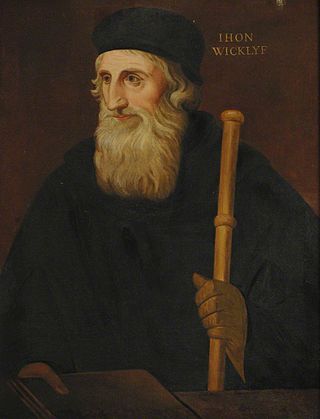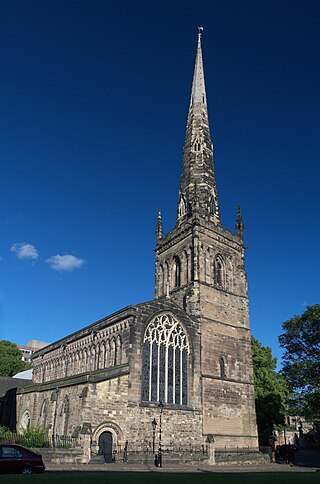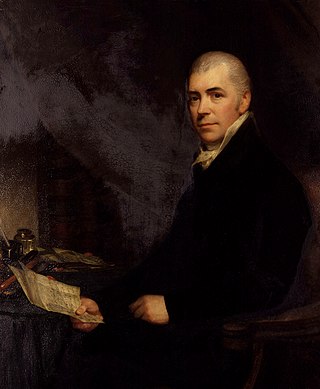Biography
Biographical information on Knighton mainly comes from his chronicle, in the first three books of which his name is shown as HENRICVS CNITTON. [3] It is thought his name indicates that he came from Knighton. [4] He was a canon at the "St Mary of the Meadows" abbey before 1363, since he was recorded as being present during a visit from King Edward III. [3] He was at the abbey for a further 33 years and in his writings included considerable detail on the abbey's economic well being. [5] The Augustinian abbey, where Henry Knighton was made a canon, was one of the wealthiest in England and stood on the northern edge of Leicester, in what is now Abbey Park. [4]
Knighton was a supporter of King Edward III and wrote well of him, [6] although historian Louisa D. Duls labels Knighton as a member of the "Lancastrian Detractors of Richard" school. [7] Knighton calls five of King Richard II's trusted advisors – Robert de Vere, Alexander Neville (Archbishop of York), Sir Michael de la Pole, 1st Earl of Suffolk (lord chancellor), Sir Robert Tresilian (chief justice of the King's Bench), and Sir Nicholas Brembre – the five evil seducers of the king ("quinque nephandi seductores regis")[ citation needed ] . [8]
Knighton lived during the same time period as John Wycliffe and had personal knowledge of him as he went to Oxford when Wycliffe was a master there. However he was neither directly associated with Wycliffe or nor with the Lollards ("Wycliffites", followers of Wycliffe's philosophies). Knighton has been called the first historian of Lollardy. [9] He writes that those voicing Church complaints and echoing the principles of Wycliffe in 1382, hence being associated with the principles of the Lollards, were every second man in the Kingdom of England. [10]
Knighton did not care for Wycliffe's church reform doctrines or the Lollards as they threatened his monastic way of life or his personal safety. [11] He respected Wycliffe as an academic scholar, however, writing that he was a famous and important ecclesiastic and philosopher of the time. [12]

John Wycliffe was an English scholastic philosopher, Christian reformer, Catholic priest, and a theology professor at the University of Oxford. Wycliffe is traditionally believed to have advocated or made a vernacular translation of the Vulgate Bible, though more recent scholarship has minimalized the extent of his advocacy or involvement for lack of direct contemporary evidence.

Lollardy, also known as Lollardism or the Lollard movement, was a proto-Protestant Christian religious movement that was active in England from the mid-14th century until the 16th-century English Reformation. It was initially led by John Wycliffe, a Catholic theologian who was dismissed from the University of Oxford in 1381 for heresy. The Lollards' demands were primarily for reform of Western Christianity. They formulated their beliefs in the Twelve Conclusions of the Lollards.
Thomas Walsingham was an English chronicler, and is the source of much of the knowledge of the reigns of Richard II, Henry IV, Henry V and the latter reign of Edward III depicting the decline of the state of affairs of the English. He also documented the careers of John Wycliff and Wat Tyler.

Thomas Arundel was an English clergyman who served as Lord Chancellor and Archbishop of York during the reign of Richard II, as well as Archbishop of Canterbury in 1397 and from 1399 until his death, an outspoken opponent of the Lollards. He was instrumental in the usurpation of Richard by his cousin Henry Bolingbroke, who became Henry IV.

Mary de Bohun was the first wife of Henry Bolingbroke, Earl of Northampton and Hereford and the mother of King Henry V. Mary was never queen, as she died before her husband came to the throne as Henry IV.

The Cathedral Church of Saint Martin, Leicester, commonly known as Leicester Cathedral, is a Church of England cathedral in Leicester, England and the seat of the Bishop of Leicester. The church was elevated to a collegiate church in 1922 and made a cathedral in 1927 following the establishment of a new Diocese of Leicester in 1926.

Wycliffe's Bible or Wycliffite Bibles or Wycliffian Bibles (WYC) are names given for a sequence of Middle English Bible translations believed to have been made under the direction or instigation of English theologian John Wycliffe of the University of Oxford. They are the earliest known literal translations of the entire Bible into English. They appeared over a period from approximately 1382 to 1395.

Robert de Beaumont, 2nd Earl of Leicester was Justiciar of England 1155–1168.

Knighton is a residential suburban area of Leicester, England. It situated between Clarendon Park to the north, Stoneygate to the east, Oadby and Wigston to the south and the Saffron Lane estate to the west.
Philip Repyngdon was a bishop and cardinal.
The Twelve Conclusions of the Lollards is a Middle English religious text containing statements by leaders of the English medieval movement, the Lollards, inspired by teachings of John Wycliffe. The Conclusions were written in 1395. The text was presented to the Parliament of England and nailed to the doors of Westminster Abbey and St Paul's Cathedral as a placard. The manifesto suggests the expanded treatise Thirty-Seven Conclusions for those that wished more in-depth information.

Knighton's Chronicon is an English chronicle written by Henry Knighton in the fourteenth century. He referred to it as his "work in hand" that he wrote while at the Augustinian Abbey of Saint Mary de Pratis, associated with the House of Lancaster, where he was a canon.

St Mary de Castro is an ancient, Grade I listed church in Leicester, England, located within the former bailey of Leicester Castle. Today it acts as a parish church in the Church of England's diocese of Leicester. "St Mary de Castro" is Latin for "St Mary of the Castle"; a name chosen to differentiate from nearby "St Mary de Pratis": "St. Mary of the Meadows".

John Waltham was a priest and high-ranking government official in England in the 14th century. He held a number of ecclesiastical and civic positions during the reigns of King Edward III and Richard II, eventually rising to become Lord High Treasurer, Lord Privy Seal of England and Bishop of Salisbury. He is buried in Westminster Abbey, London.

Henry le Despenser was an English nobleman and Bishop of Norwich whose reputation as the 'Fighting Bishop' was gained for his part in suppressing the Peasants' Revolt in East Anglia and in defeating the peasants at the Battle of North Walsham in the summer of 1381.
Events from the 1120s in England.

Sir Henry Halford, 1st Baronet, GCH, born Henry Vaughan, was president of the Royal College of Physicians for 24 years. As the royal and society physician, he was physician extraordinary to King George III from 1793 to 1820, then as physician in ordinary to his three successors – George IV, William IV and the young Victoria. He also served other members of the royal family until his death.
Honouring individuals buried in Westminster Abbey has a long tradition. Over 3,300 people are buried or commemorated in the abbey. For much of the abbey's history, most of the people buried there besides monarchs were people with a connection to the church – either ordinary locals or the monks of the abbey itself, who were generally buried without surviving markers. Since the 18th century, it has become a prestigious honour for any British person to be buried or commemorated in the abbey, a practice much boosted by the lavish funeral and monument of Sir Isaac Newton, who died in 1727. By 1900, so many prominent figures were buried in the abbey that the writer William Morris called it a "National Valhalla".

The Abbey of Saint Mary de Pratis, more commonly known as Leicester Abbey, was an Augustinian religious house in the city of Leicester, in the East Midlands of England. The abbey was founded in the 12th century by the Robert de Beaumont, 2nd Earl of Leicester, and grew to become the wealthiest religious establishment within Leicestershire. Through patronage and donations the abbey gained the advowsons of countless churches throughout England, and acquired a considerable amount of land, and several manorial lordships. Leicester Abbey also maintained a cell at Cockerham Priory, in Lancashire. The Abbey's prosperity was boosted through the passage of special privileges by both the English Kings and the Pope. These included an exemption from sending representatives to parliament and from paying tithe on certain land and livestock. Despite its privileges and sizeable landed estates, from the late 14th century the abbey began to suffer financially and was forced to lease out its estates. The worsening financial situation was exacerbated throughout the 15th century and early 16th century by a series of incompetent, corrupt and extravagant abbots. By 1535 the abbey's considerable income was exceeded by even more considerable debts.
The following is a timeline of the history of the city of Leicester, the county town of Leicestershire, in England.














